
COMMENTARY
Losing the war on drugs
Fight against heroin, opioids needs new strategies
6/8/2014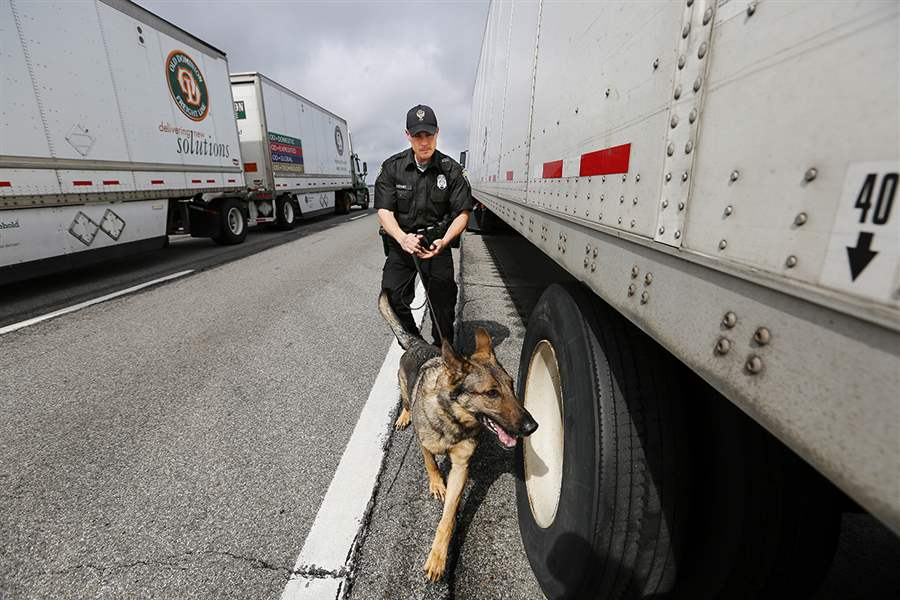
Trooper Ryan Stewart of the Ohio Highway Patrol’s criminal patrol team and his narcotics dog Oso search a tractor-trailer on the Ohio Turnpike near milepost 69. The driver and truck were released.
THE BLADE/ANDY MORRISON
Buy This Image

Gerritt
Sgt. Kurt Beidelschies of the Ohio Highway Patrol goes to work in a gray trooper’s uniform and wide-brimmed Stetson. James, a small-time local drug dealer, favors loose-fitting jeans, a black T-shirt, and baseball cap.
James is the last stop for heroin moving from Mexico to Toledo, before it’s injected or snorted into an addict’s arm or nose. It’s his job to sell heroin.
Sergeant Beidelschies heads a regional narcotics unit. It’s his job to seize the drug before it gets here — or anywhere else a courier, or mule, moving through northwest Ohio is taking it.
The two never met, but they’re locked in a vast subterranean war. Despite dedicated work by state and local law enforcement and numerous seizures, James is winning.
In more than a decade of selling drugs in Toledo, James has never seen a heroin drought. “They’re not going to stop it,” he told me in a house in central Toledo. “More people are getting turned out than ever.”

Trooper Ryan Stewart of the Ohio Highway Patrol’s criminal patrol team and his narcotics dog Oso search a tractor-trailer on the Ohio Turnpike near milepost 69. The driver and truck were released.
Last year, the state patrol seized 47,362 grams of heroin — more than 104 pounds. That’s more than five times the 8,099 grams of heroin, or roughly 18 pounds, seized in 2010. The patrol last year also confiscated more than 54,000 pills, mainly prescription painkillers, nearly double the number seized in 2010.
Toledo police seized 2,763 grams of heroin, or more than 6 pounds, last year — more than three times the amount seized in 2010. The estimated street value of last year’s take of brown, black tar, and China white heroin exceeded $1.2 million. Toledo police also seized $159,000 worth of pills.
Still, those figures represent only a fraction of the drugs moving into and through northwest Ohio — not nearly enough to cripple a drug operation.
“In this business, you can lose most of your product and still make a profit,” Sergeant Beidelschies told me during a recent ride-along. “[Suppliers] know some of their shipments are going to get picked off. It’s the cost of doing business.”
More than four decades after the nation declared a war on drugs costing hundreds of billions of dollars, Ohio and the rest of the country face another opioid and heroin epidemic. Following the explosion of prescription painkillers in the late 1990s, millions of Americans, including 200,000 in Ohio, are addicted to heroin and other opioids.
A $300 billion multinational business, drug trafficking is fueled by money, greed, and ambition. And it’s driven by something even stronger: an addict’s cravings, as every drug dealer knows.
“My customers are coming back every day,” James told me. “They have to. ... When junkies hear about someone OD’ing, they figure it was some good [stuff]. They want to know where they can get it.”
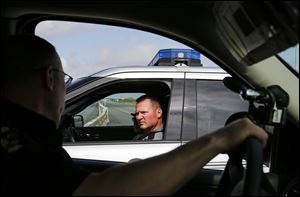
Trooper Ryan Stewart, foreground, speaks with Sgt. Kurt Beidelschies during their patrol.
Watching and waiting
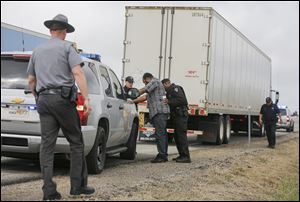
Trooper Will Richardson pats down the driver of a tractor-trailer as Troopers Ryan Stewart and Al Romero and Sgt. Kurt Beidelschies stand by along the Ohio Turnpike.
On a recent Tuesday, Sergeant Beidelschies, parked in a gray Ford Explorer in a crossover on the Ohio Turnpike in Wood County, looked for his next bust. As cars and trucks whizzed by, he waited, watching for driving patterns that to his trained eye raise suspicions: moving considerably under the speed limit, staying glued behind a truck, setting the cruise control unusually low, abruptly changing lanes when spotting an officer.
None of these acts gives a trooper probable cause to make a stop. But they can indicate a vehicle to focus on and follow. If the driver commits a violation, including unsafe lane changes, following too closely, failing to signal, not displaying a front license plate, or driving with a vehicle defect, the officer makes a stop.
Talking to the driver, troopers casually look for signs of drugs, such as multiple cell phones, foil wrappers, balloons, needles, track marks — even excessive air freshener. With truckers, long periods of logged downtime raise a red flag.
If officers see enough, they request to search the vehicle. If permission is denied, they can have a police dog sniff around. If the dog smells contraband, or “alerts,” officers have probable cause to search the vehicle.
All this may sound incredibly random and arbitrary, but such procedures are based on law enforcement experience around the country. Using them, the state patrol narcotics unit has seized hundreds of pounds of heroin and other illicit drugs.
Sergeant Beidelschies has found heroin in gas tanks, spare tires, electronic equipment, dash compartments, phony truck beds, air bag holders, suitcases, floorboards, and duffel bags. Pills are often hidden in the body cavities of female couriers, with each courier holding as many as 1,000 pills.
Over eight years, Sergeant Beidelschies has taken part in 250 to 300 drug seizures, including a commercial truck stop on I-75 he made in 2011 that yielded 8 kilos (17 pounds) of heroin. The drugs were bagged by the driver’s bunk.
Working in one of eight state patrol interdiction units around the state, Sergeant Beidelschies oversees four dog handlers who cover northwest Ohio. His unit focuses on two pipelines: I-80 connecting the southwest border to New York and I-75, linking the Canadian border to southwest Florida.
Heroin may come directly from Mexico to Toledo or go first to Detroit or Chicago. Mexican drug traffickers, refining opium poppies grown in remote regions, have found new U.S. markets for heroin in small towns, rural areas, and suburbs.
Today, the vast majority of heroin addicts are white users who became addicted to opioids through prescription painkillers such as OxyContin, Vicodin, and Percocet pills.
About 18 months ago, Sergeant Beidelschies seized 5,000 pills, after stopping a driver for speeding on I-75 in Hancock County. After pulling into a gas station, the driver told the trooper he needed gas and a pop. But he had a full tank and an unopened diet Mountain Dew on the seat. Bingo.
Usually, though, leads turn into dead ends.
As we talked, Sergeant Beidelschies pulled out to follow a late-model black Nissan Altima, a rental with Massachusetts plates traveling well below the speed limit.
The vehicle slowed to 52 mph as we got behind. The trooper pulled alongside to test the driver’s reactions. Most drivers would look over, but this driver, stiff as a board, looked dead ahead.
Sergeant Beidelschies wanted to stop him, but the driver committed no infraction. After following the car for five miles, Sergeant Beidelschies turned around. He didn’t have enough evidence to pass the driver off to another trooper. He’ll never know if his suspicions were correct.
A courier’s appearance is irrelevant. State patrol officers are seeing more older mules, men and women in their late 60s or early 70s, who might draw less attention.
Drivers can easily make $5,000 for moving 5 kilos from, say, Chicago to New York, but they can also earn five years in prison.
Later that day, Sergeant Beidelschies stopped a tractor-trailer carrying six new cars, including an uncovered black Porsche that aroused his suspicion. The $100,000 vehicle could easily be scratched in transit. The truck also had a partially obscured Washington plate.
Sergeant Beidelschies asked the driver for permission to search the vehicle. He refused, so the trooper called the K-9 handlers. Two German shepherds sniffed around the truck but didn’t alert, and there wasn’t enough evidence for a search warrant.
Another dead end.
When he’s on road duty, Sergeant Beidelschies averages five to 10 stops a day, generally issuing warnings for traffic violations. His unit averages one seizure a week — mostly heroin and prescription painkillers.
At 31, Sergeant Beidelschies has a master’s degree in criminal justice and eight years of field experience. He grew up in Cincinnati’s central city. Intelligent, professional, and thoughtful, he knows law enforcement alone won’t solve the drug problem. People making millions of dollars “peddling poison to the most vulnerable members of society” trouble him.
“You fight the good fight and do the best you can,” he told me. “They’ll be back out there tomorrow. Eventually, you’re going to catch them when they’re not having a good day and you are.”
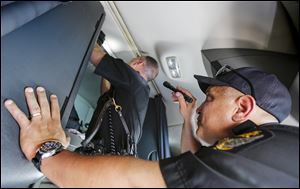
Troopers Stewart, left, and Romero search a tractor-trailer. Nothing illegal was found during the search.
Profiting from misery
James will sell heroin and pills to anyone — except pregnant girls and women. “That’s one of the rules of the game,’’ he said.
He can easily triple his investment in 10 grams of heroin by lacing it with lactose and Sleepinal, an over-the-counter sleeping aid. After he “puts in the cut,” James has at least 13 grams of product. Then he can sell it in larger quantities — $160 a gram or $80 a half gram — or “piece it out” in smaller doses. By selling 10 “folds” — a small quantity folded in paper — for $20 each, he can get $200 for a gram.
Some midlevel dealers employ kids as young as 14, James told me, paying them as much as $1,000 a week. That’s a lot of loot, especially for teenagers whose families are broke and don’t have a shot at even a minimum-wage job.
Clinics should make it easier for addicts to get Suboxone, James said, a medication that eases painful opiate withdrawal symptoms. Like prescription painkillers, however, Suboxone has been diverted; an 8 milligram strip sells for $20 on the streets.
When James was locked up recently in the county jail on drug-related charges, he watched heroin addicts withdraw: He saw them writhe, sweat, vomit, lose control of their bowels.
Smart and sensitive, James, who’s about 30, pitied the addicts. At heart, he’s an entrepreneur, a hustler who likes working for himself. Had he grown up differently, he probably would have gone to college and legitimized his hustle by starting a business. But in his neighborhood, the only people with money sold drugs.
“In the streets, it’s every boy’s dream to come up on China [heroin],” he said.
I asked him how he felt about selling so much misery.
“They’re going to do it, anyway,” he said after a pause. “If they don’t get it from me, they’ll just get it from someone else.”
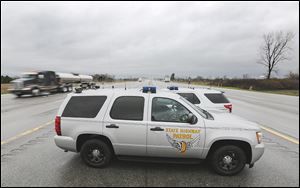
Members of the Ohio Highway Patrol keep watch on the Ohio Turnpike near mile marker 67.
Losing the battle
No one knows how much of the heroin and pill traffic headed for Toledo — or anywhere else — gets picked off, but it’s not enough to matter. The dramatic rise in heroin overdose deaths in northwest Ohio suggests there’s more of the drug than ever before.
Addiction to prescription painkillers has created an insatiable market for heroin, which is cheaper and more potent than pills. Even cops sometimes wonder whether they make a difference.
As the head of Toledo Police Department’s 13-officer vice/narcotics bureau, Lt. Sean Jones, 45, encounters the sons and daughters of some of the same people his father, a retired Toledo police narcotics officer, arrested a generation ago. The narcotics unit investigates roughly 100 drug-related complaints from citizens a week, using undercover officers and informants to make drug buys.
Like Sergeant Beidelschies, Lieutenant Jones has seen heroin destroy people. He firmly believes in treatment and education. But like the state trooper, he also believes in interdiction.
“It can make you wonder what we’re doing when we continue to lose the battle,” Lieutenant Jones said. “But do I think there’s a need for it [enforcement]? Absolutely. There’s a 100 percent need for it. Legalizing drugs isn’t going to solve the problem.”
Maybe, but decriminalizing the possession of drugs would make them less profitable for criminal enterprises. After some U.S. states and communities adopted medical marijuana laws, many farmers in Mexico stopped growing cannabis crops and switched to opium poppies, as the wholesale price of marijuana fell because of relaxed laws in the United States.
“I wish the Americans would stop with this legalization,” one lifetime Mexican cannabis farmer said in a recent Washington Post story.
What local, state, and federal law enforcement agencies have done for decades hasn’t worked. At minimum, the failures of the past 40 years suggest state and federal governments need to focus more on treatment — drying up the demand for illicit drugs — and less on enforcement.
It makes little sense for Ohio to spend tens of millions of dollars on interdiction efforts when only one in 10 addicts who need treatment gets it.
While James pushes weight (heroin) in Toledo, Sergeant Beidelschies will watch and wait on I-75 or I-80. But as long as the demand for heroin is high and profitable, people will supply it.
The war goes on, and it’s easy to see who’s winning.
Jeff Gerritt is The Blade’s deputy editorial page editor.
Contact him at: jgerritt@theblade.com, 419-724-6467, or follow him on Twitter @jeffgerritt.